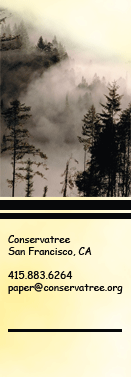About Conservatree
At Conservatree, we know environmental paper. Originally a company founded in 1976, we jump-started the markets for recycled paper and became the first national paper merchant dedicated to providing environ-mental papers in the U.S. and Canada.
In 1998, Conservatree became a nonprofit research &
consulting organization. We no longer sell paper. Instead, we provide fair, reasonable, and savvy information about all kinds of environmental papers.
<more> |




